
Red supergiants (RSGs) are stars with a supergiant luminosity class of spectral type K or M. They are the largest stars in the universe in terms of volume, although they are not the most massive or luminous. Betelgeuse and Antares A are the brightest and best known red supergiants (RSGs), indeed the only first magnitude red supergiant stars.
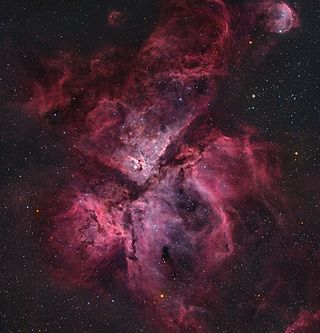
The Carina Nebula or Eta Carinae Nebula is a large, complex area of bright and dark nebulosity in the constellation Carina, located in the Carina–Sagittarius Arm of the Milky Way galaxy. The nebula is approximately 8,500 light-years (2,600 pc) from Earth.

NGC 3603 is a nebula situated in the Carina–Sagittarius Arm of the Milky Way around 20,000 light-years away from the Solar System. It is a massive H II region containing a very compact open cluster HD 97950.
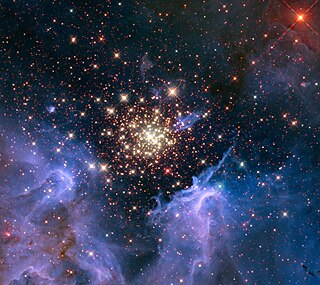
Sher 25 is a blue supergiant star in the constellation Carina, located approximately 25,000 light years from the Sun in the H II region NGC 3603 of the Milky Way. It is a spectral type B1Iab star with an apparent magnitude of 12.2. Its initial main sequence mass is calculated at 60 times the mass of the Sun, but a star of this type will have already lost a substantial fraction of that mass. It is unclear whether Sher 25 has been through a red supergiant phase or has just evolved from the main sequence, so the current mass is very uncertain.

A yellow hypergiant (YHG) is a massive star with an extended atmosphere, a spectral class from A to K, and, starting with an initial mass of about 20–60 solar masses, has lost as much as half that mass. They are amongst the most visually luminous stars, with absolute magnitude (MV) around −9, but also one of the rarest, with just 20 known in the Milky Way and six of those in just a single cluster. They are sometimes referred to as cool hypergiants in comparison with O- and B-type stars, and sometimes as warm hypergiants in comparison with red supergiants.
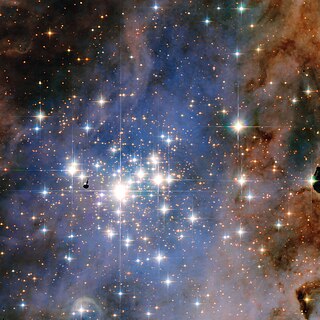
HD 93129 is a triple star system in the Carina Nebula, with all three components being hot O class stars amongst the most luminous stars in the Milky Way. It is the dominant member of the Trumpler 14 star cluster, a young star cluster within the Carina OB1 stellar association that harbors other super-luminous stars, like Eta Carinae and WR 25.

R136 is the central concentration of stars in the NGC 2070 star cluster, which lies at the centre of the Tarantula Nebula in the Large Magellanic Cloud. When originally named it was an unresolved stellar object but is now known to include 72 class O and Wolf–Rayet stars within 5 parsecs of the centre of the cluster. The extreme number and concentration of young massive stars in this part of the LMC qualifies it as a starburst region.
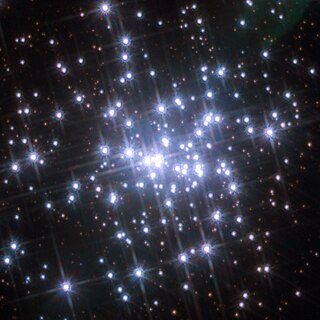
NGC 3603-A1 is a double-eclipsing binary star system located at the centre of the HD 97950 cluster in the NGC 3603 star-forming region, about 25,000 light years from Earth. Both stars are of spectral type WN6h and among the most luminous and most massive known.

R136a1 is one of the most massive and luminous stars known, at around 196 M☉ and nearly 4.7 million L☉, and is also one of the hottest, at around 46,000 K. It is a Wolf–Rayet star at the center of R136, the central concentration of stars of the large NGC 2070 open cluster in the Tarantula Nebula in the Large Magellanic Cloud. The cluster can be seen in the far southern celestial hemisphere with binoculars or a small telescope, at magnitude 7.25. R136a1 itself is 100 times fainter than the cluster and can only be resolved using speckle interferometry.

HD 5980 is a multiple star system on the outskirts of NGC 346 in the Small Magellanic Cloud (SMC) and is one of the brightest stars in the SMC.
HD 38282 is a massive spectroscopic binary star in the Tarantula Nebula, consisting of two hydrogen-rich Wolf-Rayet stars.

NGC 3603-B is a Wolf-Rayet star located at the centre of the HD 97950 cluster in the NGC 3603 star-forming region, about 25,000 light years from Earth. It has the spectral type WN6h and is among the most luminous and most massive stars known.

NGC 3603-C is a single-lined spectroscopic binary star system located at the centre of the HD 97950 cluster in the NGC 3603 star-forming region, about 25,000 light years from Earth. The primary has spectral type WN6h and is among the most luminous and most massive known.
BAT99-98 is a star in the Large Magellanic Cloud. It is located near the R136 cluster in the 30 Doradus nebula. At 226 M☉ and 5,000,000 L☉ it is one of the most massive and luminous stars known.

WR 42e is a Wolf–Rayet star in the massive H II region NGC 3603 in the constellation of the Carina. It is around 25,000 light-years or 7,600 parsec from the Sun. WR 42e is one of the most massive and most luminous stars known.

CD Crucis, also known as HD 311884, is an eclipsing binary star system in the constellation Crux. It is around 14,000 light years away near the faint open cluster Hogg 15. The binary contains a Wolf–Rayet star and is also known as WR 47.
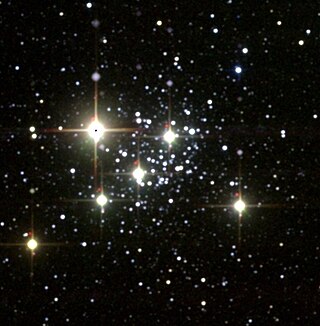
NGC 7419 is an open cluster in the constellation Cepheus. It is heavily reddened and notable for containing five red supergiants, the highest number known in any cluster until the end of the 20th century, but probably no blue supergiants.
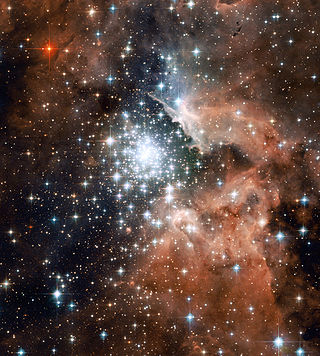
MTT 68 is a multiple star system located on the outskirts of the HD 97950 cluster in the NGC 3603 star-forming region, about 25,000 light years from Earth. It contains a rare example of an O2If* star which is one of the most luminous and most massive known.














